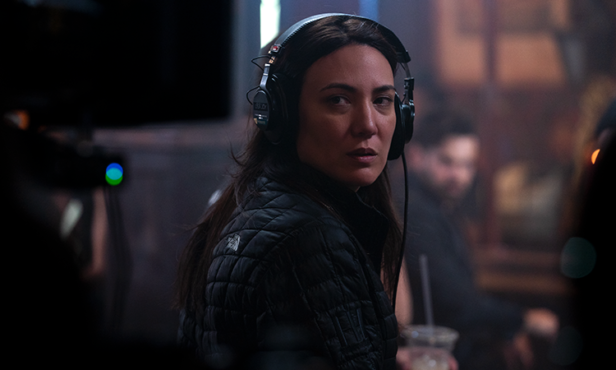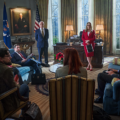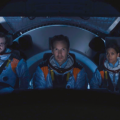“All of us sometimes time travel in our minds. We go back to revisit a parent, friend or lover. Those moments when we were different people and in different situations but at the time we felt the most alive, the happiest.”
We’re actually kind of time travelling right now as we listen back to writer and director Lisa Joy (pictured above) discuss her first film Reminiscence. We’ve just seen the first scene and Joy is telling us how the idea for the movie came about…
“After I gave birth to my daughter, I would hold her at night,” she remembers. “That first child is just crazy! You don’t sleep, you have no idea what you’re doing, and it’s all quite stressful. But at the same time, sometimes in the middle of the night, I’d be sleep-deprived and holding her and I’d smell her little head, and she’d wrap her fingers around my finger and I would think ‘this is so precious’. There is nothing else in the world that I wouldn’t give for moments like this. No awards or fancy achievements, nothing compares to the simple moments that we all have in our lives that make our lives worth living. I think those are the moments that we cherish and like to revisit in our minds.”
Reminiscence takes the idea of re-living a memory to actuality. Set in the future where oceans have risen to take up most of dry land, the film follows Nick Bannister (played by Hugh Jackman) who owns a machine that can take you back to your fondest memory for you to re-live. Not only does this machine show you that memory, you will actually feel like you’re back there. And in this future world full of poverty and crime after climate change takes back most of Earth’s land, memories are sometimes the only respite from a harsh life.
It’s no surprise, then, that Nick’s clients can’t get enough of the Reminiscence machine and its ability to take them back to a happier time. However, when his girlfriend Mae suddenly goes missing, Nick uses the machine to try and find clues of Mae’s disappearance through his own mind. However, as Nick gets deeper and deeper into his own memories, he starts to realise that perhaps Mae isn’t the person he thought she was…
“Memory is this difficult thing,” Joy continues. “It comes with its own pain, because you can recall it, you can never really fully reach it again, you can never fully live in that moment again. The details grow hazy and you lose them almost a second time when your memory begins to fade. But I thought ‘what if we didn’t have to be that way? What if there was some way that we could travel back to those memories, and relive them? That it was like we were there again, like we could smell and feel and taste and feel the butterflies in our stomach, and all the sensations that we first felt when we were experiencing them?’”
Indeed, Nick finds himself repeatedly drawn back to his own machine to re-live his happiest times with Mae and he soon starts to feel more content with her back in his memories than he is in real life without her.
“I had a class when I was younger in neuroscience, where they talked about how when patients are undergoing brain surgery, they must be kept awake, because you have to understand if you’re damaging the brain during the process. The symptoms reported when stimulating certain points of the brain that the patients would speak about were memories or sensations coming back to them. It made me think: ‘Well what if we could do that to humans?’. What if we could unlock a portion of their minds that allowed them to really immerse themselves back into memories; all the sensations they felt, all the feelings they had? That became the conceit of Reminiscence. It’s a science fiction film with an updated noir aesthetic, but it really deals with the traversing of the human heart and mind, and that inward journey along with this external journey.
“Much like in Westworld, which also meditates on memory. But in Westworld the robots have perfect recall. So perfect that it can trick you and your sense of time. Because if you can remember every single detail of something perfectly how do you know if this is now or then is now…?”
Those ideas aren’t the only things to have crossed over from Joy’s other project, Westworld, which she co-created with her husband Jonathan Nolan. Fans who have fallen in love with the show’s beautiful look will be heartened to hear that its cinematographer, Paul Cameron, also joins Joy for Reminiscence, and he was delighted to take his expertise with him: “It’s funny because Lisa was like ‘I have this kind of analogue noir romantic thriller’ and I was like ‘hmmm, never heard that one before, can you describe it?’ and [Reminiscence] was exactly like it!’” Cameron laughs. “Basically, she proposed the idea for the film, she already had the script and we read it and it was fantastic. Then she picked up the phone and called Hugh Jackman and Rebecca Ferguson…”
Ferguson plays Nick’s lost love, Mae. We mainly see her character through Nick’s memories via the Reminiscence machine which is a giant, spheric platform surrounded by a beaded curtain. Once a client is hooked up to it, Nick can view exactly what they’re remembering. Those memories are projected, in 3D, on to that platform, allowing Nick to see every aspect of that memory. It’s an astonishing-looking machine, and one that was just as astonishing to create in real life.
“For me one of the first things was ‘what is this machine?’” Cameron remembers. “In early conversations with Lisa, immediately I said ‘we’ve got to do this practically’. Somehow I have to figure out how to do it practically because we just can’t shoot for endless days with blue screen and Hugh Jackman walking around!”
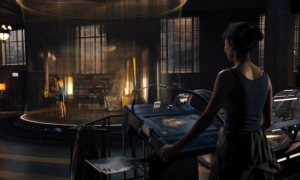
“I had this sketch of the machine as it looks now and I was like ‘I think I can do this, I just have to figure out how’,” Joy remembers. “The way that we did it was, all have the footage that you see within the machine, we had to shoot beforehand. In order to do that there’s this parallax problem that happens, depending on where the camera’s placed and how the characters watching the scene are moving. So when we were shooting the scene, sometimes months beforehand, we would have to anticipate the way in which [the characters] would move their eye-line and then we had to calibrate the angle of the camera to move at the same rate, pace and eye-line.”
“I had experience of using this kind of projection screen called holo-gauze on a film a few years ago and I pitched the idea like ‘let’s do projection on it’,” Cameron remembers. “So it has this kind of holographic feel to it. The day Hugh Jackman walked in and saw Rebecca Ferguson projected right in front of him in a perfectly scaled shot and she looked like she was singing to him, he turned back to me and gave me a massive smile and said ‘she absolutely looks real’. That was a good moment where you kind of pull a rabbit out of the hat to get that reaction, which is great.”
“It was tricky!” laughs Bruce Jones, who worked as the visual effects supervisor on the movie. “Doing that effect normally would be very straightforward – we just go ‘yeah great film it, and we will add the post effects to it’. But that isn’t what Lisa or Paul really wanted. They wanted something that would allow us to have projection on this holo-gauze material, which is sort of like a fine netting that you put over your bed. The beauty of that is that it’s semi-transparent so you can see actually through it. So, if you did a camera move around it, you’d actually see through the background.
“The reason they wanted to project on it is so that they could have moments where Rebecca Ferguson’s character Mae, could be played out with Hugh, so she’s there, he’s actually walking, looking at her, and they could almost have these moments where you feel like, ‘oh they’re together’ but [they’re not]. So that became the technical problem, that became the hard part with how do tie those two together in a way that allows Hugh to connect with her? That’s where you bring in virtual production basically. We enhanced from there to give little touches but for the most part, we figured out how to create holograms on set. That was the hard part, that was the really confusing part that I about lost my mind for about a month, but we managed to pull it off!”
“It was a real experience for the actors when they were circling it. They really did feel as though they were seeing a hologram,” Joy adds enthusiastically. “That hologram was only possible because of my lovely crew running around making it happen in real time, but it allowed for the performance to be much more organic. I wanted there to be so much emotion in those moments, and so much reality. It was a somewhat complicated thing to achieve. All the departments really banded together and made it happen so it was very exciting.
“The effect is truly spectacular, with at times Jackman and Ferguson almost interacting on screen, even though one of them is a projection. Part practical effect, part-CGI, it was important that everyone made sure the Reminiscence machine looked perfect.”
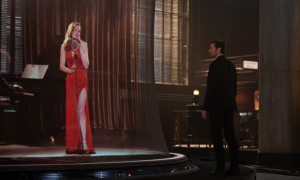
Indeed, if Jones, Cameron and Joy thought that was the machine was the only tough element on the movie, they were sorely mistaken. Reminiscence is set in a world primarily made of water, and with water comes a whole tsunami of problems in itself.
“The other the other massive challenge was certainly the water,” Cameron nods. “You think about it like ‘how bad could it be?’ well picture night after night on that little south Miami beach facade and the abandoned Six Flags park outside of New Orleans where there’s countless alligators and wild boars surrounding you and you’re standing in three to four feet of water, constantly in the dark. It’s kind of a mental and physical challenge for sure. Then we flooded warehouses and abandoned schools. So there were a lot of times when we were in water and it’s a challenge to be in the water that much. You don’t think of it that way but it is very tiring walking back and forth in waders all the time. It got to the point of when you would break for lunch, instead of taking everything off you just kind of go sit on the dock and wait 20 minutes before you head back!”
Due to the dilapidation caused by the severe flooding, the world of Reminiscence is oceans away from the polished, futurism of Cameron’s work on Westworld. Indeed, most of the aesthetics in the movie are old and worn, not that they’re any less beautiful.
“Lisa’s vision of it was that it’s become kind of an analogue dystopian future,” Cameron explains. “That we’ve gone through the kind of [Ray] Bradbury image of the future. By then, the water levels would be up and people would be taking boats to work and it’d be too hard to work in the daytime. That was the basis for the film. Early on people were kind of describing it as a noir-type script but for us, it was more like a contemporary version of that. We didn’t want to pay homage to noir, we basically developed our own feel for it. We didn’t want it to be referential or anything in any way to what we’ve seen before.”
“It has in its bones the noir genre for some of the constructs and conceits, but I wanted to take that look behind the tropes and archetypes, and deconstruct them a little bit, much like in Westworld where I was working within a western framework,” Joy describes. “In this, I was looking at noir, a genre I very much admire, and wanted to do my own spin on. So the first thing that I wanted to subvert was the notion of noir itself, the darkness, and the night is the place where sin occurs. I had been travelling in Spain for Westworld shortly after Season Three and I was noticing the siestas in the afternoon when people take a break because it’s very, very hot. I thought, ‘well at the rate that Miami is going, no one’s going to want to go outside during the day, what happens if we take that concept and drive it even further? The entire city becomes nocturnal.
“With that as an underlying assumption, the idea of noir itself became inverted because everything that is dark and seedy in the underbelly of the world occurs in the scorching light of day when the streets are abandoned and everybody’s at home. Meanwhile, the city comes to life at night, when the weather drops, and everybody starts going to work and going to school. So I thought it was a somewhat romantic way to invert that and also play with the beauty of the architecture and the art deco lighting and such in Miami.”
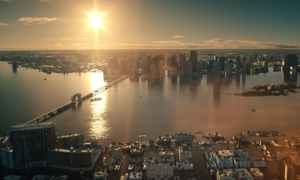
Speaking of romantic, at the centre of this story is the relationship between Nick and Mae, giving it an underlying optimistic feel, even in the dystopian world the characters find themselves in. “I think that’s the strength of the movie, that it is a very optimistic film,” Cameron says. “It’s about two people finding love, even though they can’t share it in this lifetime.”
“We know the oceans are going to rise, we know the temperature is going to get higher, but this film also tells us that humans will adapt, they’ll survive and people will meet and fall in love and families will continue on,” Jones adds. “I think it’s really a message of hope. Not that that’s the key part of this film, but it’s one of the ingredients that makes it.”
Indeed, like most good memories, Reminiscence has many elements. It builds on a well-known genre idea and takes it to a whole new level, while throwing in a couple of well-loved tropes and a twist or two for good measure.
“It’s really a multi layered type of film. Like Westworld there’s no real black and white,” Jones continues. “I think that’s part of the beauty of the story, and what we were just trying to do visually was tell all of that as best we could.”
“Traditionally it’s like, ‘oh there’s the bad girl, the good girl, the stoic guy, and the terrible villain’, and I didn’t want any of those archetypes, those stark black and white characterisations to exist in this. This film is very much about the dismantling of those archetypes. You think ‘oh, this is just this kind of person’, but no one is only one kind of person. We all have our reasons for being who we are. I don’t believe in absolute villainy, nor do I believe in absolute goodness, because if they were absolute there would be no point in trying to do better and this is a film about people trying to survive and trying to do better, and people trying to make real connections.”
Whether it’s people trying to make real connections or attempting to find some respite in an increasingly damaged world, it’s good to know that the person behind Reminiscence very much appreciates why people like to lose themselves in a good memory or even, perhaps, a good film…
“I very much like to be entertained, and I don’t think that there needs to be this disparity between artistry, emotion and sense of sensuality, and the things that we’ve come to expect from a big blockbuster movie. I also think intellectualism and thoughtfulness is something that makes the viewer want to engage, unlocking the mystery is always fun for me. So I tried to embed all of those things that I enjoy, into the film.”
You can lose yourself in Reminiscence now on Sky Cinema.
